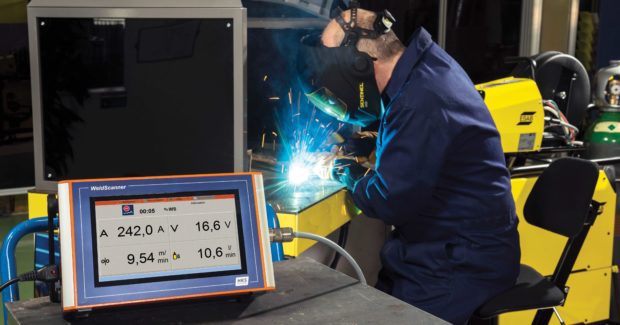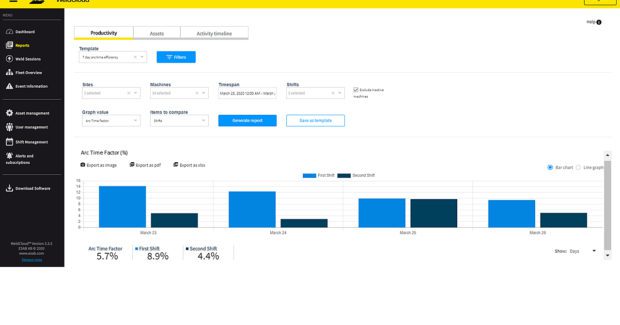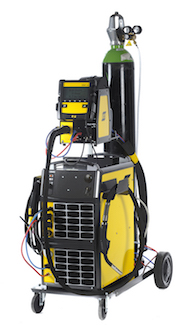How to (Safely and Securely) Use the Cloud to Improve Welding and Cutting Operations
Fabricators tend to operate by anecdotal evidence and company history. Data-management tools like ESAB’s Digital Solutions can help companies understand — and move the needle on — their true drivers of productivity.
Posted: April 7, 2020
Most fabricators believe their welders spend 30 to 40% of their time welding, but boots-on-the-ground time clock studies prove differently. Even the most-experienced semi-automatic MIG welding operations have an average arc-on time in the middle teens. In the bigger picture, many shops do not know the actual metrics driving productivity or the cost of quality. As the saying goes, if you can’t measure it, how can you improve it?
While optimizing a welding process remains a priority, fabricators can make bigger gains by using insights gained from cloud-based data management solutions. These solutions work by digitally connecting welding systems and using applications that gather and analyze data to improve asset management, traceability, documentation, and quality control.
Unfortunately, many shops shy away from cloud-based solutions because they assume they require significant IT resources, fear the cost or complexity, and worry about the security of their data. Fortunately, solutions are getting easier to deploy. Here’s why:
- Inverter-based welding power sources designed for high-volume fabrication are now available with an optional communications module (“IIoT box”) that connects the power source to the cloud wirelessly or to an in-house router by an ethernet cable.
- For companies with older or analog equipment, “universal connection” modules can capture and communicate arc-on/-off time and voltage and amperage data from nearly any power source with a positive and negative terminal.
- Cloud-based solutions that use platforms such as Microsoft’s Azure are extremely secure and reliable. As far as the user is concerned, the technology remains in the background, reducing the IT burden.
- As with consumer apps and office software, cloud-based data dashboards have become much more user-friendly. They operate with almost point-and-click simplicity from any web-enabled device.
- Scanning apps using a smart phone gather shop-floor data, even in places without an immediate internet connection. Operators scan their badges, parts, shielding gas and filler metals, and the information is logged centrally as part of the weld session data.
Cloud-Computing
Welders are familiar with basic apps, such as those for parameter settings, heat input, and interpass temperatures. However, these apps are not connected to the fabricator’s system, nor do they generate reports.
Conversely, online data-management systems such as WeldCloud from the ESAB Digital Solutions suite enable users to perform analyses and data drilldowns by directly connecting to the customer’s welding database. All the data being used comes from the fabricator’s own database, which can be housed in the cloud, on a local server, or a hybrid solution of both. All data is secured by a firewall and password-protected.
Today, the phrase “in the cloud” should generate reassurance. For example, Microsoft Azure is one of the most dominant cloud-computing platforms, and is used by 95% of Fortune 500 companies. Cloud-based platforms are becoming the preferred solution because they generally cost less, offer flexibility, and reduce downtime due to maintenance; theft is almost non-existent.
In 2018, ESAB migrated all Digital Solutions elements to a unified platform powered by Azure. The move enabled the company to offer a seamless experience across the entire fabrication workflow by making it easier to share data between components (including welding and cutting operations), as well as leverage Microsoft’s resources. This lets ESAB focus its resources on supporting welding and cutting applications and customers.
Driving Productivity
With WeldCloud, users access high-level dashboards with one click and can generate reports on total arc time, average arc time per weld, number of weld sessions, total weight of wire used, wire used by each station, average machine errors per session for a fleet of machines.
After deployment, fabricators can establish benchmarks against which to measure improvement efforts instead of using anecdotal information. The goal is to avoid predictions based on estimations that could cost money. By capturing actual operator time and consumable and material use, fabricating companies can increase profit margins by accurately calculating job costs.
Another good step is linking production variables with results. For example, many shops have an operator who boasts “I like to weld hot and fast” — but has anyone ever verified whether “hot and fast” yields the most productivity? If it leads to spatter, grinding, and rework down the line, a “slow and steady” operator puts more parts out the door.
The ideal situation is to have everyone using consistent parameters. An online data-management system that manages process settings enables a fabricating company to monitor its best welders or welding cells, link welding variables to productivity and quality results, and push those results out to an entire fleet or enterprise.
However, data-management solutions must be used as a positive, not punitive, tool. In an era where finding talent remains a challenge, you must do everything possible to help employees turn out more parts. In shops where welders get paid by the part, tracking tools make compensation more straightforward. By identifying the most productive welders, the operations manager can boost arc-on time by shifting a highly-productive welder’s nonvalue-added tasks to a helper. A fabricator of agricultural equipment increased MIG welding arc-on time from 10% to 20% using this tactic.
The tools also help supervisors identify operators who need additional training and work with them to eliminate the root cause of their issues (for example, weld flaws might be a simple matter of using the correct gun angle). WeldCloud also enables companies to spot anomalies, such as low arc-on time or wire consumption, and then determine a root cause. If an operator spends too much time grinding, is it because of spatter or a poorly prepared bevel? If so, investing in a low-spatter wire or automated plasma beveling system might make sense.
Traceability and Documentation
Data-driven systems will eventually change the way quality teams work. Using an app, they can click on a part number and drill down to find out who touched the part and when without having to manually manipulate or extract data. With the need for documentation and traceability growing, especially in the power, wind tower, offshore, pressure vessel, and shipbuilding industries, connected solutions will become invaluable.
After a weld is performed, a customer may request documentation that validates quality. WeldCloud facilitates traceability from single welds to the complete product because the core of the system is a comprehensive database containing key information for every weld seam. As a result, the supervisor of one operation reduced documentation time by one hour per week, per welding station. For many shops, such savings justify exploring cloud-based solutions.
The WeldCloud app logs data at a rate of 1 Hz, which is best-in-class performance. While suitable for macro decisions, only a real-time weld quality analytics system provides the micro details required by engineers and quality assurance personnel. Ready for connection to WeldCloud, the HKS WeldQAS system (HKS is an ESAB brand) captures data at 23 kHz (and 234 kHz for stud welding). By comparing measured parameters with reference curves, the system calculates quality marks for each weld seam and provides an instant notification when an irregularity occurs. Faults detected can include poor arc ignition, porosity, burn-through, seam length (too long or short), and seam interruption.
Maintenance Benefits
Maintenance teams, especially at large operations, will appreciate a connected system.
For example, they can instantly receive alerts, such as when a system suddenly shuts down, runs outside of parameter limits, or is about to run out of consumables. In one real-world example, a cloud-based solution diagnosed faults that occurred when the end-user forgot to put coolant into a water-cooled system.
More proactively, maintenance personnel can gather data that enables them to make more informed decisions about maintenance intervals and evaluate consumable life as part of a cost/benefit analysis (wouldn’t it be nice to know for sure which contact tip lasted longer?).
When it comes to replenishing consumables, a maintenance team would traditionally rely on suppliers or sending a person around to check levels. With a connected system, a message could be sent automatically.
In summary, cloud-based and connected systems help fabricators become better at what they do best: fabrication. By automating data collection and through user-friendly apps, they can improve asset management, streamline documentation/traceability, increase quality and boost overall operation efficiency — and that’s money they can take to the bank.

















